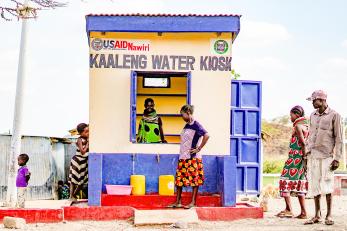Breadcrumb
Nawiri: Sustainably Reducing Malnutrition in Northern Kenya
Nawiri is an eight-year (2019 – 2027) Resilient Food Security Activity (RFSA) implemented by a Mercy Corps-led consortium of international and national partners. By 2027, Nawiri aims to reach 598,475 individuals across Kenya’s Samburu and Turkana counties, and sustainably reduce the rate of persistent acute malnutrition (PAM) to 12%.
Nawiri’s multi-sectoral interventions are sequenced, layered and integrated to maximize self-reliance and autonomy, and put individuals, communities and local governments in the drivers seat of their journey towards nutrition resilience.
To address the immediate, underlying and systemic drivers of malnutrition, Nawiri centers its approach around four interconnected purpose areas. Each purpose area has a corresponding approach brief that details how Nawiri is operationalized.
- Purpose 1: Vulnerable households maintain food security despite exposure to shocks and stresses.
- Purpose 2: Vulnerable households have a low disease burden.
- Purpose 3: Stable and resilient nutrition enabling environment.
- Purpose 4: Formal institutions monitor, learn and adapt to more effectively manage and scale interventions to prevent and respond to acute malnutrition.

Learning Briefs
- Fostering Resilience and Adaptation to Drought
- Resilient Livelihoods Systems for Nutrition
- Building Market Linkages with Last Mile Livestock Traders
- Banking the Last Mile through Savings Groups
- Ujuzi Mashinani: Promoting Diversified Skills and Livelihoods Opportunities for Improved Nutrition Resilience
- Improving Adolescent Sexual and Reproductive Health (ASRH) for Sustainable Reductions in Persistent Acute Malnutrition
- Building Resilient Markets in Food Systems
- Unpacking the Conflict, Climate, Environment and Nutrition Nexus
- Cost of Diet
- The Influence of Gender and Social Dynamics on Nutrition Outcomes
- Governance and Systems Strengthening for Nutrition
- Household Economic Analysis of Samburu and Turkana Counties
- Labor Market
- Longitudinal Study+ (Nutrition Dynamics)
- Milk Availability during the Dry Season
- Maternal, Infant and Young Child Nutrition
- Pathways for Improved Nutrition Outcomes for the Ultra-Poor
- Resilient Community Health Systems




